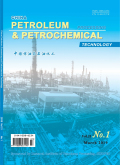- 钛学术文献服务平台 \
- 学术期刊 \
- 工业技术期刊 \
- 石油与天然气工业期刊 \
- 中国炼油与石油化工(英文版)期刊 \
Synthesis of H2WO4/GO and Its Oxidative Desulfurization Activity
Synthesis of H2WO4/GO and Its Oxidative Desulfurization Activity
基本信息来源于合作网站,原文需代理用户跳转至来源网站获取
摘要:
H2WO4/GO catalyst was synthesized by the immersion method and was characterized by using X-ray diffraction (XRD), Fourier-transform infrared spectroscopy (FT-IR), scanning electron microscopy (SEM), and nitrogen adsorption-desorption measurements (BET). The characterization results show that H2WO4 has been dispersed on GO (grapheme oxide). H2WO4/GO was used as catalyst in the oxidative desulfurization of dibenzothiophene (DBT), with H2O2 acting as oxidant and acetonitrile acting as extraction agent. The experimental results show that the sulfur removal rate for DBT reach 99.2%, that for 4,6-dimethyldibenzothiophene (4,6-DMDBT) reach 95% and that for benzothiophene (BT) reach 42.8% under the optimal reaction conditions. Meanwhile, the recycled catalysts still exhibits good desulfurization performance after four operating cycles. The high activity and stability of catalysis is attributed to a small dose of H2WO4, which is highly dispersed inside the layers of GO. This desulfurization reaction follows the pseudo-first-order kinetics, and the apparent activation energy of the desulfurization reaction is 18.515 kJ/mol, which indicates that the H2WO4/GO used as desulfurization catalyst has demonstrated good desulfurization property for DBT.

推荐文章
H2WO4/GO的制备及其超声-氧化脱除模拟油中的硫化物
钨酸
氧化石墨烯
超声
氧化脱硫
二苯并噻吩
Na2WO4·2H2O-H2O2催化氧化苯甲醛制备苯甲酸
钨酸钠
苯甲醛
苯甲酸
表面活性剂
硫酸氢钠
催化
CH4/C2H6/C3H8在MOF-505@5GO上吸附相平衡和选择性
MOF-505@GO
甲烷
乙烷
丙烷
吸附(作用)
二元混合物
Synthesis of zinc oxide–montmorillonite composite and its effect on the removal of aqueous lead ions
Synthesis
Characterization
Zinc oxide–montmorillonite composite
Adsorption, Pb2+ ions
内容分析
关键词云
关键词热度
相关文献总数
(/次)
(/年)
文献信息
| 篇名 | Synthesis of H2WO4/GO and Its Oxidative Desulfurization Activity | ||
| 来源期刊 | 中国炼油与石油化工(英文版) | 学科 | |
| 关键词 | |||
| 年,卷(期) | 2021,(2) | 所属期刊栏目 | Scientific Research |
| 研究方向 | 页码范围 | 66-76 | |
| 页数 | 11页 | 分类号 | |
| 字数 | 语种 | 英文 | |
| DOI | |||
五维指标
引文网络
引文网络
二级参考文献 (42)
共引文献 (16)
参考文献 (35)
节点文献
引证文献 (0)
同被引文献 (0)
二级引证文献 (0)
2002(1)
- 参考文献(1)
- 二级参考文献(0)
2003(2)
- 参考文献(1)
- 二级参考文献(1)
2004(1)
- 参考文献(0)
- 二级参考文献(1)
2005(2)
- 参考文献(1)
- 二级参考文献(1)
2006(1)
- 参考文献(1)
- 二级参考文献(0)
2007(3)
- 参考文献(0)
- 二级参考文献(3)
2008(3)
- 参考文献(2)
- 二级参考文献(1)
2009(5)
- 参考文献(2)
- 二级参考文献(3)
2010(7)
- 参考文献(2)
- 二级参考文献(5)
2011(5)
- 参考文献(1)
- 二级参考文献(4)
2012(8)
- 参考文献(5)
- 二级参考文献(3)
2013(6)
- 参考文献(2)
- 二级参考文献(4)
2014(3)
- 参考文献(1)
- 二级参考文献(2)
2015(9)
- 参考文献(4)
- 二级参考文献(5)
2016(12)
- 参考文献(4)
- 二级参考文献(8)
2017(5)
- 参考文献(4)
- 二级参考文献(1)
2018(2)
- 参考文献(2)
- 二级参考文献(0)
2019(2)
- 参考文献(2)
- 二级参考文献(0)
2021(0)
- 参考文献(0)
- 二级参考文献(0)
- 引证文献(0)
- 二级引证文献(0)
引文网络交叉学科
相关学者/机构
期刊影响力
中国炼油与石油化工(英文版)
主办单位:
中国石化集团石油化工科学研究院
出版周期:
季刊
ISSN:
1008-6234
CN:
11-4012/TE
开本:
大16开
出版地:
北京海淀学院路18号
邮发代号:
创刊时间:
1999
语种:
eng
出版文献量(篇)
1608
总下载数(次)
0
总被引数(次)
1651
期刊文献
相关文献
推荐文献
- 期刊分类
- 期刊(年)
- 期刊(期)
- 期刊推荐
一般工业技术
交通运输
军事科技
冶金工业
动力工程
化学工业
原子能技术
大学学报
建筑科学
无线电电子学与电信技术
机械与仪表工业
水利工程
环境科学与安全科学
电工技术
石油与天然气工业
矿业工程
自动化技术与计算机技术
航空航天
轻工业与手工业
金属学与金属工艺
中国炼油与石油化工(英文版)2022
中国炼油与石油化工(英文版)2021
中国炼油与石油化工(英文版)2020
中国炼油与石油化工(英文版)2019
中国炼油与石油化工(英文版)2018
中国炼油与石油化工(英文版)2017
中国炼油与石油化工(英文版)2016
中国炼油与石油化工(英文版)2015
中国炼油与石油化工(英文版)2014
中国炼油与石油化工(英文版)2013
中国炼油与石油化工(英文版)2012
中国炼油与石油化工(英文版)2011
中国炼油与石油化工(英文版)2010
中国炼油与石油化工(英文版)2009
中国炼油与石油化工(英文版)2008
中国炼油与石油化工(英文版)2007
中国炼油与石油化工(英文版)2006
中国炼油与石油化工(英文版)2005
中国炼油与石油化工(英文版)2004
中国炼油与石油化工(英文版)2003
中国炼油与石油化工(英文版)2002
中国炼油与石油化工(英文版)2001
中国炼油与石油化工(英文版)2000

 免费查重
免费查重










